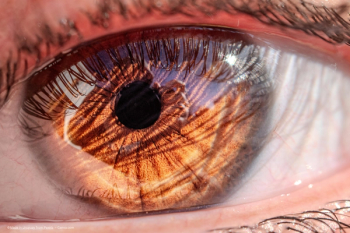
Pressure-independent factors in glaucoma
Glaucoma is a final pathway of amny different disorders that can lead to a common pattern of optic nerve and visual field damage
Speaking at the recent World Ophthalmology Congress in Berlin, Dr Robert Ritch referred to glaucoma as an 'end stage,' analogous to congestive heart or liver failure.
"It's a final pathway of many different disorders that can lead to a common pattern of optic nerve and visual field damage. It is the first or second leading cause of irreversible blindness in virtually every country in the world and we estimate that there are probably 100 million people with glaucoma. Ten million of them are blind. Now, for 100 years glaucoma was thought of as being high pressure in the eye or equated with high pressure in the eye. Some patients were reported as having normal pressures but people explained it away. We started a society called the Von Graefe society last year to bring everything together in what I shall refer to as normal tension glaucoma. When I say that I'm really talking about risk factors in relation to intraocular pressure. Elevated IOP is only a risk factor and not the disease itself."
Glaucoma often exists and progresses at normal or even low IOP levels, on the basis of IOP-independent risk factors. Pressure-independent risk factors have only just begun to be explored. Norman-tension glaucoma (NTG) is not a distinct disorder, but a portion of the spectrum of primary open-angle glaucoma (POAG). The difference between NTG and high tension glaucoma lies, for practical purposes, in the weight given to IOP-dependent and IOP-independent risk factors for optic nerve and visual field damage. NTG was once thought to be extremely rare. We now know that this was largely a failure on the part of ophthalmologists to make the diagnosis successfully. It accounts for an astounding 90 per cent of the open-angle glaucoma in Japan, 80 per cent in Korea and around 30 per cent in Europe and the USA.
At the moment there are no proven pharmaceutical methods to treat the aforementioned factors and all commercial glaucoma therapy involves lowering IOP. However, as Dr Ritch points out, there are many natural compounds available with actions that offer potential neuroprotection and inhibit apoptosis. These include ginkgo biloba, resveratrol, pycnogenol, fish oil, curcumin and aerobic exercise.
Steps towards finding a cure
The Glaucoma Research Foundation's Catalyst for a Cure team (CFC) is now in its ninth year of its collaborative research programme and have made great progress as Dr Philip Horner explained in a recent president's teleconference with members of the Catalyst Circle: "I am optimistic because we have proof that our approach works. What I mean by that is that we've studied this particular model of glaucoma and our studies have led us to be able to make predictions of what underpins the disease. We've taken those predictions and conducted pre-clinical models, or pre-clinical trials, in which we've had multiple successes in which we've intervened and the disease has been slowed. That makes me very excited that this is a pliable disease and we can change the course of the disease.
"We now have data tat shows that you can protect the ganglion cell by increasing its resistance to oxidative stress. We have evidence that you can influence its survival by indirectly blocking the pressure signal through a protein that ganglion cells make; we have data that suggests you can slow the disease by manipulating support cells called the microglia. We have another set of data that suggests you can slow the disease by inhibitiing another type of glial cell called the astrocyte. So, we've discovered all of these things, none of which cure the disease, they only slow it.
"Why I'm so excited is that I don't know of any other disease in which we've pinned down so many important mechanisms and if we can find a 'linker' between these, I think we'll cure the disease. I'm very enthusiastic that that's possible and I don't think it's unrealistic to believe that we will find a common mediator for these varying cell types and varying pathways - one in which we'll shut the whole degenerative programme down, or slow it down so much that it will essentially be a cure."
In summary
In conclusion Dr Ritch said: "Systemic factors and other abnormalities in glaucoma will be more easily elucidated once we find the bottom markers and genes and that risk factors, other than IOP, account for a much larger proportion of glaucoma damage than people previously thought."
Newsletter
Get the essential updates shaping the future of pharma manufacturing and compliance—subscribe today to Pharmaceutical Technology and never miss a breakthrough.




